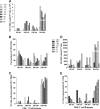HLA-DR+ CD38+ CD4+ T lymphocytes have elevated CCR5 expression and produce the majority of R5-tropic HIV-1 RNA in vivo
- PMID: 21813616
- PMCID: PMC3196402
- DOI: 10.1128/JVI.02529-10
HLA-DR+ CD38+ CD4+ T lymphocytes have elevated CCR5 expression and produce the majority of R5-tropic HIV-1 RNA in vivo
Abstract
Percentages of activated T cells correlate with HIV-1 disease progression, but the underlying mechanisms are not fully understood. We hypothesized that HLA-DR(+) CD38(+) (DR(+) 38(+)) CD4(+) T cells produce the majority of HIV-1 due to elevated expression of CCR5 and CXCR4. In phytohemagglutinin (PHA)-stimulated CD8-depleted peripheral blood mononuclear cells (PBMC) infected with HIV-1 green fluorescent protein (GFP) reporter viruses, DR(-) 38(+) T cells constituted the majority of CCR5 (R5)-tropic (median, 62%) and CXCR4 (X4)-tropic HIV-1-producing cells (median, 61%), although cell surface CCR5 and CXCR4 were not elevated in this subset of cells. In lymph nodes from untreated individuals infected with R5-tropic HIV-1, percentages of CCR5(+) cells were elevated in DR(+) 38(+) CD4(+) T cells (median, 36.4%) compared to other CD4(+) T-cell subsets (median values of 5.7% for DR(-) 38(-) cells, 19.4% for DR(+) 38(-) cells, and 7.6% for DR(-) 38(+) cells; n = 18; P < 0.001). In sorted CD8(-) lymph node T cells, median HIV-1 RNA copies/10(5) cells was higher for DR(+) 38(+) cells (1.8 × 10(6)) than for DR(-) 38(-) (0.007 × 10(6)), DR(-) 38(+) (0.064 × 10(6)), and DR(+) 38(-) (0.18 × 10(6)) subsets (n = 8; P < 0.001 for all). After adjusting for percentages of subsets, a median of 87% of viral RNA was harbored by DR(+) 38(+) cells. Percentages of CCR5(+) CD4(+) T cells and concentrations of CCR5 molecules among subsets predicted HIV-1 RNA levels among CD8(-) DR/38 subsets (P < 0.001 for both). Median HIV-1 DNA copies/10(5) cells was higher in DR(+) 38(+) cells (5,360) than in the DR(-) 38(-) (906), DR(-) 38(+) (814), and DR(+) 38(-) (1,984) subsets (n = 7; P ≤ 0.031). Thus, DR(+) 38(+) CD4(+) T cells in lymph nodes have elevated CCR5 expression, are highly susceptible to infection with R5-tropic virus, and produce the majority of R5-tropic HIV-1. PBMC assays failed to recapitulate in vivo findings, suggesting limited utility. Strategies to reduce numbers of DR(+) 38(+) CD4(+) T cells may substantially inhibit HIV-1 replication.
Figures









Similar articles
-
Differential susceptibility of resting CD4(+) T lymphocytes to a T-tropic and a macrophage (M)-tropic human immunodeficiency virus type 1 is associated with their surface expression of CD38 molecules.Virus Res. 2001 Jan;73(1):1-16. doi: 10.1016/s0168-1702(00)00220-3. Virus Res. 2001. PMID: 11163640
-
Preferential susceptibility of Th9 and Th2 CD4+ T cells to X4-tropic HIV-1 infection.AIDS. 2017 Oct 23;31(16):2211-2215. doi: 10.1097/QAD.0000000000001630. AIDS. 2017. PMID: 28857825 Free PMC article.
-
CCR5 expression is elevated on endocervical CD4+ T cells in healthy postmenopausal women.J Acquir Immune Defic Syndr. 2012 Mar 1;59(3):221-8. doi: 10.1097/QAI.0b013e31823fd215. J Acquir Immune Defic Syndr. 2012. PMID: 22083068 Free PMC article.
-
Chronic Immune Activation and CD4+ T Cell Lymphopenia in Healthy African Individuals: Perspectives for SARS-CoV-2 Vaccine Efficacy.Front Immunol. 2021 Jun 17;12:693269. doi: 10.3389/fimmu.2021.693269. eCollection 2021. Front Immunol. 2021. PMID: 34220854 Free PMC article. Review.
-
Nanoparticles containing siRNA to silence CD4 and CCR5 reduce expression of these receptors and inhibit HIV-1 infection in human female reproductive tract tissue explants.Infect Dis Rep. 2011 Sep 7;3(2):e11. doi: 10.4081/idr.2011.e11. eCollection 2011 Sep 7. Infect Dis Rep. 2011. PMID: 24470908 Free PMC article. Review.
Cited by
-
CCR5 promoter haplotypes differentially influence CCR5 expression on natural killer and T cell subsets in ethnically divergent HIV-1 uninfected South African populations.Immunogenetics. 2012 Nov;64(11):795-806. doi: 10.1007/s00251-012-0642-0. Epub 2012 Aug 15. Immunogenetics. 2012. PMID: 22893032
-
The Penis, the Vagina and HIV Risk: Key Differences (Aside from the Obvious).Viruses. 2022 May 27;14(6):1164. doi: 10.3390/v14061164. Viruses. 2022. PMID: 35746636 Free PMC article. Review.
-
An HIV-1 replication pathway utilizing reverse transcription products that fail to integrate.J Virol. 2013 Dec;87(23):12701-20. doi: 10.1128/JVI.01939-13. Epub 2013 Sep 18. J Virol. 2013. PMID: 24049167 Free PMC article.
-
IL-21 induces antiviral microRNA-29 in CD4 T cells to limit HIV-1 infection.Nat Commun. 2015 Jun 25;6:7562. doi: 10.1038/ncomms8562. Nat Commun. 2015. PMID: 26108174 Free PMC article.
-
Genital Immune Cell Activation and Tenofovir Gel Efficacy: A Case-Control Study.Clin Infect Dis. 2022 Sep 29;75(6):1088-1091. doi: 10.1093/cid/ciac115. Clin Infect Dis. 2022. PMID: 35142337 Free PMC article.
References
Publication types
MeSH terms
Substances
Grants and funding
LinkOut - more resources
Full Text Sources
Research Materials

